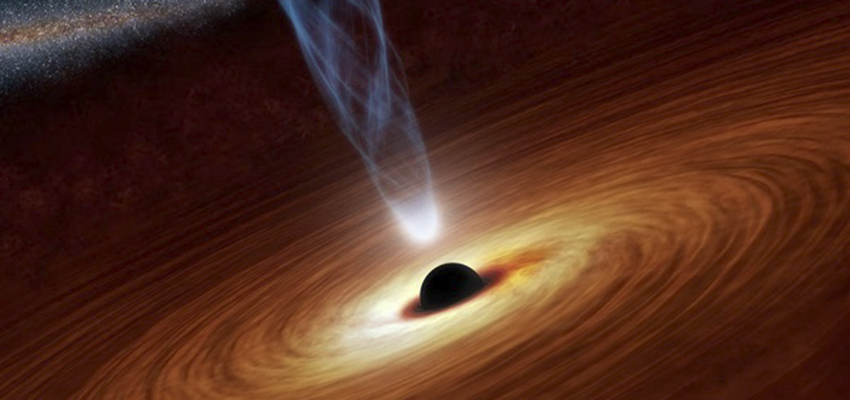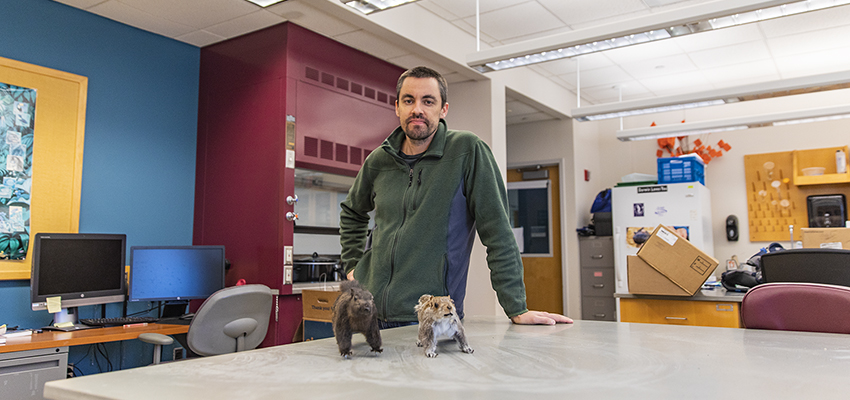
HWS News
15 October 2020 • Faculty • Research Black Holes, Astrophysics and the 2020 Nobel
This month, the Nobel Prize in Physics was awarded to three scientists whose research on black holes has pushed astrophysics into new territory, recognizing “areas of physics that have become critical for our fundamental understanding of the universe,” says Associate Professor of Physics Steven Penn, whose work supported the discoveries honored with the Nobel in 2017.
On Tuesday, Oct. 6, the Royal Swedish Academy named the 2020 Nobel winners: Roger Penrose “for the discovery that black hole formation is a robust prediction of the general theory of relativity,” and Reinhard Genzel and Andrea Ghez “for the discovery of a supermassive compact object at the center of our galaxy.”
“Black holes, when first realized as a consequence of GR (general relativity), were a concept that disturbed a great many people. Penrose demonstrated that black holes were an inevitable consequence of GR. The concept may be unsettling to some, but it is one that we’ve incorporated into our current model of the universe,” says Penn. He also notes that black holes “are taking an increasingly important role in astrophysics as we begin to use the catalog of black hole observations to build models for black hole populations (how many of what mass) and how they were formed.”
Genzel and Ghez collected decades of data on the dynamics of stars in the galactic nucleus in order to understand the forces exerted by the supermassive black hole about which these stars orbited, Penn explains. “While they could not observe the black hole directly, Genzel and Ghez could calculate its mass and location from the motion of these stars. Their work advances our understanding of the dynamics of spiral galaxies and informs our models of the evolution of the supermassive black holes that we observe at their center.”
Penn is an instrumental and longstanding member of the global research team that made the historic discovery of gravitational waves through their observations of a binary black hole system. That breakthrough — which measured for the first time the ripples in the fabric of spacetime predicted by Albert Einstein’s 1915 general theory of relativity — was recognized with the 2017 Nobel Prize in Physics, awarded to the project’s pioneers and leaders, Rainer Weiss of MIT and Barry Barish and Kip Thorne of the California Institute of Technology.
The Academy’s acknowledgment of astrophysicists over the past several years reflects the increasing importance of the field, Penn says, “where new instrumental innovations have opened up opportunities for new observations — and that fuels new theory.”
It has become difficult and expensive to construct particle accelerators at ever increasing energies. Facing these technological limits, some particle physicists are looking to astrophysics to “use the cosmos as a laboratory,” as Penn says, in part because of “major developments in our ability to make astronomical measurements, including gravitational wave detectors and extremely large, terrestrially-based telescopes. These observations can inform us about the particle dynamics that occur in the most energetic events in the universe. For example, the collision of neutron stars informs our understanding of the exotic particle dynamics in the star’s core.” In addition, the advances in one area of physics are not isolated to that subfield. “The innovations within astrophysics and gravitational wave physics percolate out into other areas and elevate our entire field and eventually all of society. Our advances move physics and the world forward, and that is very exciting.”
An MIT-trained physicist, Penn joined the HWS Physics Department in 2002 following postdoctoral fellowships at University of Washington and Syracuse University. It was at Syracuse, in 1998, that he became a member of LIGO Scientific Collaboration (LSC), an international group of more than 1,300 researchers focused on the direct detection of gravitational waves as a means to explore the fundamental physics of gravity and to advance astronomical discovery. Hobart and William Smith became one of the first small colleges to join the LSC when Penn joined the faculty.
Penn was a co-author of the Physical Review Letters article announcing the 2015 detection of gravitational waves by LIGO. In 2017, for his work pioneering the discovery of gravitational waves, Penn was among the international team of scientists recognized with the prestigious and highly selective Special Breakthrough Prize in Fundamental Physics, through which Penn was awarded a “Breakthrough Prize: Scientists Changing the World” medal.
Penn’s original LSC research was on the mirror design for Advanced LIGO (Laser Interferometer Gravitational-Wave Observatory). He discovered how to significantly reduce the thermal noise in the material fused silica, which led to the selection of fused silica for the Advanced LIGO mirror substrates and suspensions. He was also a developer of the mirror coatings for Advanced LIGO, providing the sensitivity required to detect gravitational waves.
In 2019, Penn was elected Chair of the LSC Council. In the LSC organizational structure, akin to a parliamentary body, the position of Chair corresponds to the Speaker of Parliament, a central role in the management and execution of the group’s mission and goals. The LSC spokesperson is the position that, like the Prime Minister, is the leader of the collaboration. Penn has previously chaired the LSC Coating Working Group, a subcommittee of the Optics Working Group, which is developing coatings for future detectors.
The photo above provided by NASA/JPL-Caltech is an illustration of a supermassive black hole that is millions to billions times the mass of our sun.



